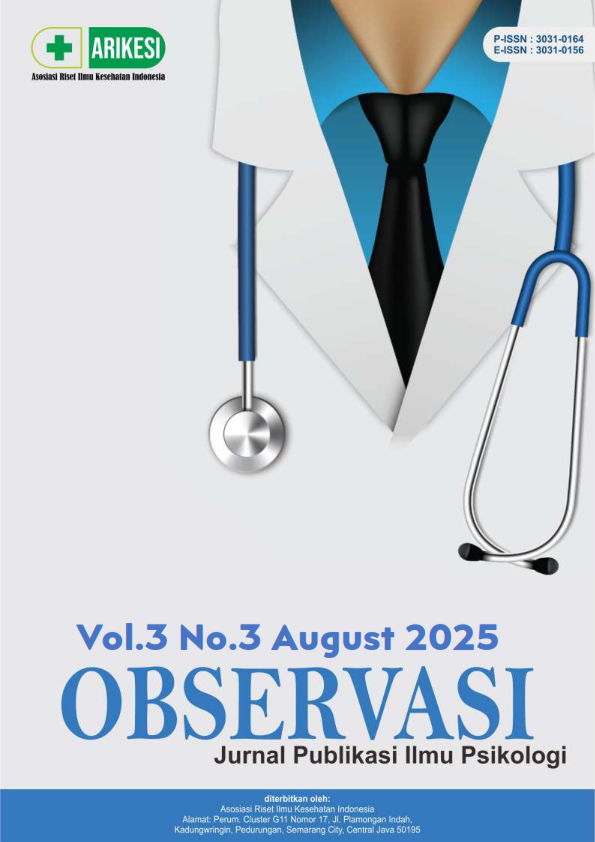Mengenali Depresi Anak Sejak Dini : Kajian Teoritis dan Implikasi Praktis
DOI:
https://doi.org/10.61132/observasi.v3i3.1481Keywords:
Childhood Depression, Mental Health, Early Intervention, Risk Factors, PsychotherapyAbstract
The purpose of this study was to examine the phenomenon of depression in children with a focus on early identification, risk factors, and effective treatment approaches. The method used in this study was a narrative literature review that synthesized findings from various scientific journals, academic books, and reports from world health organizations related to depression in children. The results of the analysis indicate that depression in children is a real clinical condition but is often undiagnosed due to differences in symptoms compared to adults and lack of public awareness. The main risk factors include childhood trauma, genetics, and dysfunctional family dynamics. Evidence-based approaches such as cognitive-behavioral therapy (CBT), family therapy, and psychosocial interventions have shown effectiveness in reducing symptoms. The conclusion of this study emphasizes the importance of early detection and intervention as a preventive measure to minimize the long-term impact on children's mental health.
Downloads
References
Angold, A., & Costello, E. J. (1994). Depressive comorbidity in children and adolescents: Empirical, theoretical, and methodological issues. Annual Progress in Child Psychiatry and Child Development, 441-468.
Birmaher, B., Brent, D., & AACAP Work Group on Quality Issues. (2007). Practice parameter for the assessment and treatment of children and adolescents with depressive disorders. Journal of the American Academy of Child & Adolescent Psychiatry, 46(11), 1503-1526.
Costello, E. J., Mustillo, S., Erkanli, A., Keeler, G., & Angold, A. (2003). Prevalence and development of psychiatric disorders in childhood and adolescence. Archives of general psychiatry, 60(8), 837-844.
Depression, W. H. O. (2017). Other common mental disorders: global health estimates. Geneva: World Health Organization, 24(1).
Fergusson, D. M., McLeod, G. F., & Horwood, L. J. (2013). Childhood sexual abuse and adult developmental outcomes: Findings from a 30-year longitudinal study in New Zealand. Child abuse & neglect, 37(9), 664-674.
Hughes, K., Bellis, M. A., Hardcastle, K. A., Sethi, D., Butchart, A., Mikton, C., ... & Dunne, M. P. (2017). The effect of multiple adverse childhood experiences on health: a systematic review and meta-analysis. The Lancet public health, 2(8), e356-e366.
Kessler, R. C., Berglund, P., Demler, O., Jin, R., Merikangas, K. R., & Walters, E. E. (2005). Lifetime prevalence and age-of-onset distributions of DSM-IV disorders in the National Comorbidity Survey Replication. Archives of general psychiatry, 62(6), 593-602.
Klein, D. N., Schatzberg, A. F., McCullough, J. P., Dowling, F., Goodman, D., Howland, R. H., ... & Keller, M. B. (1999). Age of onset in chronic major depression: relation to demographic and clinical variables, family history, and treatment response. Journal of affective disorders, 55(2-3), 149-157.
Kovacs, M., Obrosky, S., & George, C. (2016). The course of major depressive disorder from childhood to young adulthood: Recovery and recurrence in a longitudinal observational study. Journal of affective disorders, 203, 374-381.
Loeber, R. (2002). Three longitudinal studies of children's development in Pittsburgh: the Developmental Trends Study, the Pittsburgh Youth Study, and the Pittsburgh Girls Study. Crim. Behav. & Mental Health, 12, 1.
Luby, J. L. (2010). Preschool depression: The importance of identification of depression early in development. Current directions in psychological science, 19(2), 91-95.
Luby, J. L., Belden, A. C., & Spitznagel, E. (2006). Risk factors for preschool depression: the mediating role of early stressful life events. Journal of Child Psychology and Psychiatry, 47(12), 1292-1298.
Reinherz, H. Z., Giaconia, R. M., Silverman, A. B., Friedman, A., Pakiz, B., Frost, A. K., & Cohen, E. (1995). Early psychosocial risks for adolescent suicidal ideation and attempts. Journal of the American Academy of Child & Adolescent Psychiatry, 34(5), 599-611.
Thapar, A., Collishaw, S., Pine, D. S., & Thapar, A. K. (2012). Depression in adolescence. The lancet, 379(9820), 1056-1067.
Weisz, J. R., Kuppens, S., Ng, M. Y., Eckshtain, D., Ugueto, A. M., Vaughn-Coaxum, R., ... & Fordwood, S. R. (2017). What five decades of research tells us about the effects of youth psychological therapy: A multilevel meta-analysis and implications for science and practice. American Psychologist, 72(2), 79.
Downloads
Published
How to Cite
Issue
Section
License
Copyright (c) 2025 Observasi : Jurnal Publikasi Ilmu Psikologi

This work is licensed under a Creative Commons Attribution-ShareAlike 4.0 International License.





